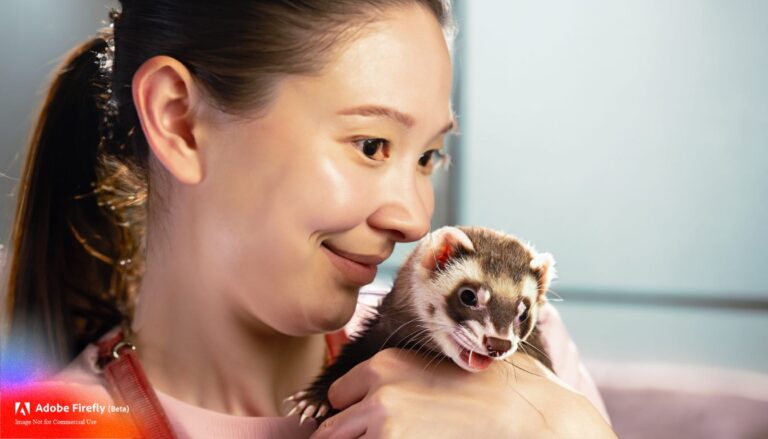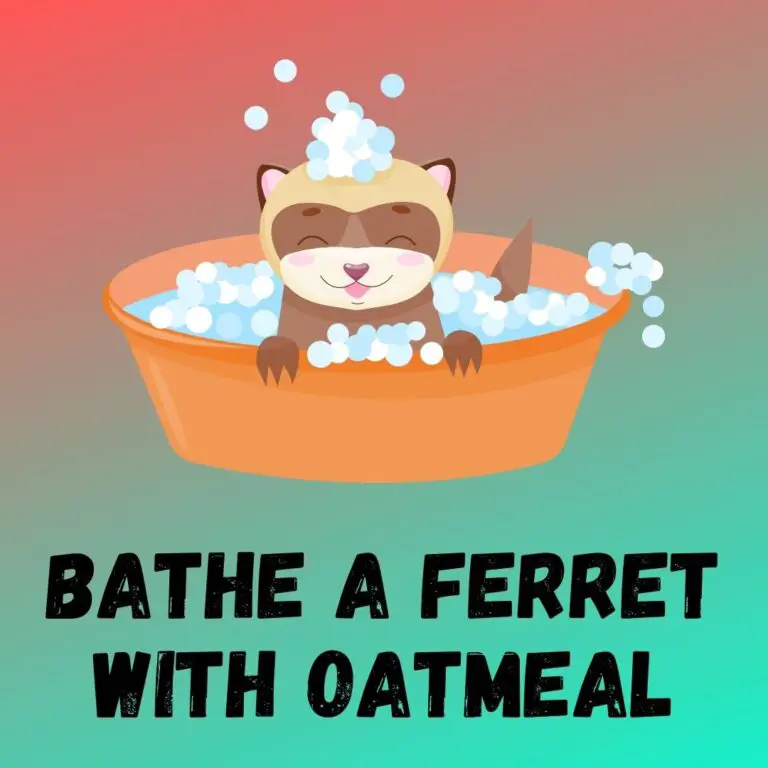
When it comes to comparing ferrets and minks, there are some striking similarities and noticeable differences that set them apart. As someone who has spent years studying and observing these fascinating creatures, I can confidently say that understanding the distinctions between ferrets and minks is essential for any animal enthusiast. In this article, I’ll delve into the world of ferrets and minks, exploring their physical characteristics, behaviors, and habitats, to help shed light on what makes each of them unique. So, whether you’re considering getting a pet or simply curious about these remarkable animals, join me as we unravel the intriguing differences between ferrets and minks.
Ferrets and minks may seem like distant relatives, but upon closer inspection, you’ll discover that they belong to the same family, Mustelidae. However, don’t be fooled by their shared lineage, as ferrets and minks have distinct physical features that set them apart. From their size and coloration to their facial structure and tail length, each species possesses its own set of characteristics that make them easily distinguishable. So, if you’ve ever wondered how to tell a ferret from a mink, or if you’re simply intrigued by the diversity within the Mustelidae family, this article is for you.
While ferrets and minks may look similar at first glance, their behaviors and habitats couldn’t be more different. Understanding the unique traits and preferences of these animals is crucial for their well-being, whether they are kept as pets or observed in the wild. By exploring their natural habitats and social behaviors, we can gain a deeper appreciation for the fascinating lives of ferrets and minks. So, let’s dive into the world of these captivating creatures and uncover the intriguing contrasts that make them stand out from one another.
Physical Characteristics of Ferrets and Minks
When it comes to physical characteristics, there are both similarities and differences between ferrets and minks.
Ferrets are small carnivores, known for their long, slender bodies and short legs. They have a distinctive face with a pointed snout, small ears, and round, dark eyes. Their fur is thick and soft, typically ranging in color from white to shades of brown and black. One interesting fact about ferrets is that they have a natural musky odor, which can be controlled with proper grooming and hygiene.
On the other hand, minks are also small, but they are slightly larger than ferrets. They have a similar body shape, but their fur is denser and provides excellent insulation. Minks come in various colors, including black, brown, and a rare white variant called the “marbled mink.” Unlike ferrets, minks have a more robust and muscular build, making them excellent swimmers.
Both ferrets and minks belong to the same family, Mustelidae, but have distinct features that set them apart. While they may look similar at first glance, a closer examination reveals their unique characteristics and adaptations for their respective habitats.
Understanding the physical characteristics of ferrets and minks is important not only for distinguishing between the two species, but also for their overall care and welfare. Whether they are kept as pets or observed in the wild, recognizing their specific needs and behaviors is crucial for providing them with a suitable environment.
Facial Structure and Body Features
When it comes to facial structure and body features, ferrets and minks have some distinct differences that set them apart.
Ferrets have a unique face with a pointed snout, giving them a distinctive look. Their eyes are small and round, and their ears are short and upright. One characteristic that stands out is their whiskers, which are long and sensitive, helping them navigate their surroundings.
In terms of body build, ferrets have a long and slender physique. Their legs are short, but they are incredibly agile and can move swiftly. Their fur is another notable feature, which is thick and soft to the touch. Ferret fur comes in a range of colors, from white to shades of brown and black. It’s truly fascinating to see the beautiful variety of fur patterns among ferrets.
Minks, on the other hand, have a more robust and muscular build compared to ferrets. They have a broader face and a strong, square-shaped snout. Minks also have larger eyes and rounded ears. They possess sharp retractable claws that aid them in hunting and climbing.
What sets minks apart is their denser fur, which provides excellent insulation. This is essential for their survival in colder climates. Minks come in various colors, including black, brown, and a rare white variant called the “marbled mink”. Their fur is coveted for its exceptional quality and is often used in the fashion industry.
While ferrets and minks share similarities in terms of their facial features and body structures, it’s the subtle differences that make each species unique. Understanding these characteristics is crucial for the care and welfare of both species, whether they are kept as pets or observed in the wild.
Next, let’s delve into their natural habitats and behaviors to gain a deeper understanding of these fascinating creatures.
Size and Coloration
When comparing ferrets and minks, one noticeable difference lies in their size and coloration. Let’s dive into the details.
Ferret Size and Coloration
Ferrets are generally smaller in size compared to minks. On average, ferrets measure around 20 inches in length, including their tail. They typically weigh between 1.5 to 4 pounds.
In terms of coloration, ferrets exhibit a wide range. Their fur can be seen in various hues, including white, cream, chocolate, sable, and black. Some ferrets even have unique patterns like marked face masks or patches on their bodies.
Mink Size and Coloration
Minks, on the other hand, possess a more robust and muscular build compared to ferrets. They are larger and heavier, with the average mink measuring around 22 inches in length, excluding the tail. Their weight can range from 1.5 to 3 pounds.
Minks also have a diverse color palette. Their fur comes in shades of brown, black, and even a rare white variant known as the “marbled mink.” This stunning coloration makes the marbled mink a sought-after variety.
Understanding the size and coloration differences between ferrets and minks is essential for their care and identification, whether they are kept as pets or found in the wild. It can assist with species recognition and ensure their well-being in various environments.
Tail Length and Shape
Now let’s shift our attention to another interesting aspect of both ferrets and minks – their tail length and shape.
Ferrets:
Ferrets have relatively short and bushy tails. Typically, their tails measure around 5 to 6 inches in length. The tail is covered in the same thick and plush fur that extends along the rest of their body. The shape of the tail is cylindrical, similar to that of a tube. This unique tail characteristic adds to the overall adorable appearance of ferrets.
Minks:
On the other hand, minks possess long and slender tails. Their tails can measure up to 7 to 8 inches in length, slightly longer than that of ferrets. Minks have a more pronounced tapering effect towards the tip of their tails, resulting in a more slender and elegant appearance. The tail is covered in dense fur, providing insulation and aiding in swimming.
The difference in tail length and shape between ferrets and minks is another distinct feature that sets them apart. While ferrets have shorter and bushier tails, minks possess longer and more slender tails. These tail variations play a role in their respective behaviors and interactions with their environment.
It’s important to note that the variation in tail length and shape is just one of the many characteristics that make each of these animals unique. Understanding these differences contributes to our knowledge and appreciation of these fascinating creatures.
So far, we have explored the physical characteristics of ferrets and minks, focusing on their unique face shapes, body sizes, fur textures, and tail lengths. Each aspect gives valuable insight into the distinct characteristics of these animals. Stay tuned as we continue to delve into more intriguing comparisons between ferrets and minks, shedding light on their behaviors, habitats, and more.
Behaviors and Habits of Ferrets and Minks
Ferrets and minks have distinct behaviors and habits that set them apart. As an expert in these animals, I’ll share some interesting insights into how they behave and what drives their habits.
1. Ferret Behaviors:
- Social creatures: Ferrets are highly social animals and thrive in the company of others. They enjoy playing and interacting with both humans and other ferrets.
- Curious and explorative: Ferrets have an innate curiosity and love to explore their surroundings. They will investigate every nook and cranny, making them great escape artists.
- Napping enthusiasts: Ferrets are known for their love of sleep. They spend a considerable amount of time napping, often up to 18 hours a day.
2. Mink Behaviors:
- Solitary animals: Unlike ferrets, minks are solitary creatures and prefer to live and hunt alone. They establish territories and fiercely guard them against intruders.
- Skilled hunters: Minks are proficient hunters, with excellent swimming and diving abilities. They primarily feed on fish but are also known to target small mammals, birds, and amphibians.
- Nocturnal by nature: Minks are primarily nocturnal animals, meaning they are active during the night. This behavior helps them avoid predators and find their prey more easily.
- Carnivorous diet: Both ferrets and minks are carnivores and require a diet high in protein. They have sharp teeth and a strong bite, allowing them to consume meat easily.
- Scent marking: Both species use scent marking to communicate with each other and establish their territory. They have scent glands that produce a distinctive scent to signal their presence.
Understanding the behaviors and habits of ferrets and minks helps us appreciate their unique characteristics. It’s fascinating to see how their natural instincts drive their actions, whether it’s the sociability of ferrets or the solitary nature of minks. By observing and learning about them, we can better provide for their needs and ensure their well-being.
Differences in Social Behaviors
When it comes to social behaviors, ferrets and minks show marked differences. Let’s take a closer look at how these fascinating creatures interact with others of their species:
Ferrets: As I mentioned earlier, ferrets are highly social animals. They thrive on companionship and enjoy the company of both other ferrets and humans. In fact, ferrets are known to form strong bonds with their owners, often seeking out their attention and affection. This social nature is one of the reasons why ferrets make wonderful pets for those who are willing to provide them with the necessary love and interaction.
Minks: In contrast, minks are solitary creatures. They prefer to spend their time alone, avoiding contact with others of their kind. This behavior is thought to be linked to their hunting habits, as minks are skilled and stealthy hunters. By being solitary, minks can focus on their hunting pursuits without the distraction of others. Additionally, minks tend to be more aggressive and territorial than ferrets, further reinforcing their inclination towards a solitary lifestyle.
While ferrets and minks differ in their social behaviors, both species communicate using scent marking. By leaving their scent on objects or surfaces, they establish their territory and convey messages to other individuals of their species. This form of communication is particularly important for minks, who rely on scent marking to warn others to stay away from their hunting grounds.
Understanding these social behaviors is crucial for providing appropriate care and enrichment for both ferrets and minks. For ferrets, it’s important to ensure they have plenty of social interaction and companionship. This can be achieved through regular playtime, allowing them to interact with other ferrets, or even by adopting another ferret to keep them company. For minks, providing them with space and privacy is key to honoring their solitary nature.
- Ferrets are highly social animals and enjoy companionship, including interaction with humans.
- Minks prefer a solitary lifestyle to focus on their hunting pursuits.
- Both ferrets and minks use scent marking to communicate and establish territory.
- Understanding the social behaviors of these animals is important for providing appropriate care and enrichment.
Unique Traits and Preferences
When it comes to their unique traits and preferences, ferrets and minks have some interesting differences. As I mentioned earlier, ferrets are highly social animals and enjoy companionship. They thrive in interactive environments and are known for their playful and curious nature. In fact, ferrets are often compared to kittens, as they have a similar level of energy and mischievousness.
On the other hand, minks are solitary animals by nature. They prefer a more independent lifestyle and are quite self-reliant. Minks are skilled hunters and spend a majority of their time focusing on their hunting pursuits. Due to their solitary nature, minks are less likely to seek out social interaction and prefer to spend their time alone.
Not only do ferrets and minks differ in their social preferences, but they also have distinct habitat requirements. Ferrets are adaptable creatures and can be kept as pets in an appropriate and enriched environment. They need plenty of space to play and explore, as well as toys and hiding spots to keep them mentally stimulated. It’s also crucial to provide ferrets with social interaction, either with other ferrets or with humans, to ensure their emotional well-being.
On the other hand, minks are wild animals and are not commonly kept as pets. They require large areas to roam and hunt, and their hunting instincts are deeply ingrained. Attempting to keep a mink as a pet would not only be challenging and potentially dangerous, but it would also prevent them from living their natural, solitary lifestyle.
Understanding the unique traits and preferences of ferrets and minks is essential for providing appropriate care and enrichment. Whether you’re considering a ferret as a pet or simply interested in learning about these fascinating animals, recognizing their social behavior and habitat needs is vital to their well-being.
Natural Habitats of Ferrets and Minks
Ferrets and minks have distinct natural habitats that reflect their different behavioral and lifestyle preferences. Understanding these habitats is crucial for providing appropriate care and enrichment for these animals. Let’s delve into the unique habitats of ferrets and minks:
Ferret Natural Habitat:
Ferrets are native to Europe and have been domesticated for thousands of years. In the wild, ferrets primarily inhabit grasslands and forest edges. They are highly adaptable and can live in a variety of environments, including deserts, mountains, and human-made habitats like farms and buildings.
Ferrets are burrowers by nature and prefer areas with dense vegetation and underground tunnels. These burrows provide them with shelter and protection from predators. They are also excellent climbers and can be found in trees or bushes.
Mink Natural Habitat:
On the other hand, minks are wild animals that inhabit various parts of North America, Europe, and Asia. They have a preference for riparian environments, which are areas near water bodies such as rivers, lakes, and wetlands.
Minks are highly skilled swimmers and spend a significant amount of time in the water, hunting for fish and other aquatic prey. They use their muscular bodies and webbed feet to navigate through the water with ease. Minks also create burrows near the water’s edge for shelter.
Due to their independent and solitary nature, minks prefer habitats that offer seclusion and ample opportunities for hunting. They can be found in forests, marshes, and even coastal areas.
A Comparison of Habitats:
While ferrets and minks have some similarities in their natural habitats, such as their preference for burrows and sheltered areas, their overall habitats differ significantly. Here’s a quick comparison:
| Ferret | Mink | |
|---|---|---|
| Native Regions | Europe | North America, Europe, Asia |
| Preferred Habitat | Grasslands, forest edges | Riparian environments |
| Main Activities | Burrowing, climbing | Swimming, hunting |
| Social Structure | Highly social | Solitary |
Understanding the distinct habitats of ferrets and minks helps us create suitable environments for them in captivity. Providing them with naturalistic enclosures, hiding spots, and stimulating activities helps mimic their natural habitats and promotes their physical and mental well-being.
Contrasting Environments
When comparing the natural habitats of ferrets and minks, it becomes evident that these two animals thrive in very different environments. Understanding their distinct habitats is crucial for providing suitable living conditions for them in captivity.
Ferrets:
Ferrets are native to Europe and have the remarkable ability to adapt to a variety of environments. They can be found in grasslands, forests, deserts, mountains, and even human-made habitats such as farms or homes.
In their natural habitats, ferrets are skilled burrowers and climbers. They often seek shelter and protection in underground tunnels, trees, or bushes. This behavior allows them to access food sources, hide from predators, and create safe spaces for breeding and raising their young.
When designing an environment for pet ferrets, it’s essential to provide them with opportunities for burrowing and climbing. Creating tunnels, providing platforms, and incorporating hiding spots will mimic their natural habitat and promote their physical and mental well-being.
Minks:
Minks, on the other hand, have a different set of preferences when it comes to their natural habitat. They are found in North America, Europe, and Asia, with a particular affinity for riparian environments near water bodies.
One notable characteristic of minks is their exceptional swimming ability. They spend a considerable amount of time in the water, hunting for fish and other aquatic prey. Their muscular bodies and webbed feet allow them to navigate through the water effortlessly.
To recreate a suitable environment for minks in captivity, it’s crucial to provide them with access to water. Incorporating pools or aquariums into their living space enables them to engage in their natural swimming and hunting behaviors. Additionally, creating burrows near the water’s edge allows them to seek shelter and security when needed.
By understanding the specific environmental needs of ferrets and minks, we can ensure that they are kept in environments that promote their natural behaviors and overall well-being. Providing them with opportunities to engage in their instinctual activities not only benefits their physical health but also enhances their mental stimulation.
Conclusion
Understanding the differences between ferrets and minks is crucial for providing appropriate care and enrichment for these animals. Ferrets are highly social creatures that thrive in interactive environments, while minks prefer a more solitary lifestyle focused on hunting pursuits. While ferrets can be kept as pets in suitable and enriched environments, minks are wild animals and not commonly kept as pets due to their need for large areas to roam and hunt.
The natural habitats of ferrets and minks also play a significant role in their well-being. Ferrets are native to Europe and can adapt to various environments, including grasslands, forests, deserts, mountains, and human-made habitats. They are burrowers and climbers, seeking shelter and protection in underground tunnels, trees, or bushes. On the other hand, minks are found in North America, Europe, and Asia, with a preference for riparian environments near water bodies. They are skilled swimmers and spend time hunting in the water, using their muscular bodies and webbed feet.
By providing pet ferrets with opportunities for burrowing and climbing, and ensuring that minks have access to water for swimming and hunting, we can promote their physical and mental well-being in captivity. Understanding these distinct habitats allows us to create suitable environments that mimic their natural surroundings.
By recognizing the unique traits, behaviors, and habitats of ferrets and minks, we can ensure their health and happiness in our care.






